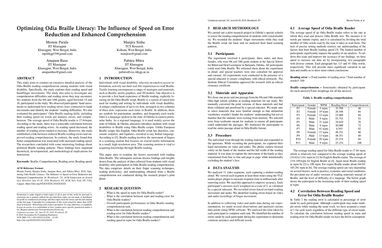Optimizing Odia Braille Literacy: The Influence of Speed on Error Reduction and Enhanced Comprehension
This study aims to conduct an extensive detailed analysis of the Odia Braille reading comprehension among students with visual disability. Specifically, the study explores their reading speed and hand or finger movements. The study also aims to investigate any comprehension difficulties and reading errors they may encounter. Six students from the 9th and 10th grades, aged between 14 and 16, participated in the study. We observed participants hand movements to understand how reading errors were connected to hand movement and identify the students reading difficulties. We also evaluated the participants Odia Braille reading skills, including their reading speed (in words per minute), errors, and comprehension. The average speed of Odia Braille reader is 17.64wpm. According to the study, there was a noticeable correlation between reading speed and reading errors. As reading speed decreased, the number of reading errors tended to increase. Moreover, the study established a link between reduced Braille reading errors and improved reading comprehension. In contrast, the study found that better comprehension was associated with increased reading speed. The researchers concluded with some interesting findings about preferred Braille reading patterns. These findings have important theoretical, developmental, and methodological implications for instruction.
PDF Abstract
